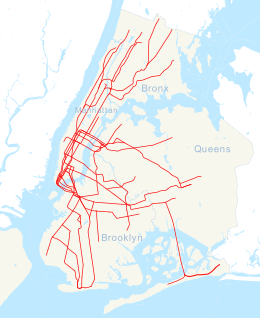110th Street station (IRT Lexington Avenue Line)
110th Street is a local station on the IRT Lexington Avenue Line of the New York City Subway. Located in East Harlem at the intersection of 110th Street and Lexington Avenue, it is served by the 6 train at all times, the <6> train during weekdays in the peak direction, and the 4 train during late nights.
110 Street | |||||||||||
|---|---|---|---|---|---|---|---|---|---|---|---|
_by_David_Shankbone.jpg) Platform level | |||||||||||
| Station statistics | |||||||||||
| Address | East 110th Street & Lexington Avenue New York, NY 10029 | ||||||||||
| Borough | Manhattan | ||||||||||
| Locale | East Harlem | ||||||||||
| Coordinates | 40.794773°N 73.944426°W | ||||||||||
| Division | A (IRT) | ||||||||||
| Line | IRT Lexington Avenue Line | ||||||||||
| Services | 4 6 | ||||||||||
| Transit connections | |||||||||||
| Structure | Underground | ||||||||||
| Platforms | 2 side platforms | ||||||||||
| Tracks | 4 | ||||||||||
| Other information | |||||||||||
| Opened | July 17, 1918[1] | ||||||||||
| Station code | 394[2] | ||||||||||
| Accessible | not ADA-accessible; accessibility planned | ||||||||||
| Wireless service | |||||||||||
| Opposite-direction transfer available | No | ||||||||||
| Traffic | |||||||||||
| Passengers (2019) | 3,316,061[4] | ||||||||||
| Rank | 150 out of 424[4] | ||||||||||
| Station succession | |||||||||||
| Next north | 116th Street: 4 | ||||||||||
| Next south | 103rd Street: 4 | ||||||||||
| |||||||||||
| |||||||||||
| |||||||||||
History
110th Street opened on July 17, 1918 as part of an expansion of the IRT Lexington Avenue Line north of Grand Central–42nd Street.[1]
In 2002, it was announced that 110th Street would be one of ten subway stations citywide to receive renovations.[5] In 2019, the Metropolitan Transportation Authority announced that the station would become ADA-accessible as part of the agency's 2020–2024 Capital Program.[6]
Station layout
| G | Street level | Entrances/exits |
| P Platform level |
Side platform | |
| Northbound local | ← ← | |
| Northbound express | ← | |
| Southbound express | | |
| Southbound local | | |
| Side platform | ||
This underground station has four tracks and two side platforms. The two center express tracks are used by the 4 and 5 trains during daytime hours. Both platforms have their original trim line, which has "110" tablets on it at regular intervals, and name tablets, which read "110TH STREET" in Times New Roman font.
Each platform has one same-level fare control area at the center. Each one has a turnstile bank, token booth, and two street stairs. The ones on the southbound platform go up to either western corners of Lexington Avenue and 110th Street while the ones on the northbound platform go up to either eastern corners. There are no crossovers or crossunders to allow a free transfer between directions.
The artwork at this station is a mosaic entitled Un Sabado en la Ciento Diez (A Saturday on 110th), by Manuel Vega in 1996.[7]
Exits
| Exit location[8] | Exit Type | Number of exits | Platform served |
|---|---|---|---|
| NW corner of Lexington Avenue and 110th Street | Staircase | 1 | Southbound |
| SW corner of Lexington Avenue and 110th Street | Staircase | 1 | Southbound |
| NE corner of Lexington Avenue and 110th Street | Staircase | 1 | Northbound |
| SE corner of Lexington Avenue and 110th Street | Staircase | 1 | Northbound |
The northbound platform had a second exit towards the north end leading to 111th Street, but was closed due to safety and security reasons and covered over in 1992. The only evidence of this exit is a steel door in the wall.[9]
References
- "Lexington Av. Line to be Opened Today" (PDF). The New York Times. July 17, 1918. p. 13. ISSN 0362-4331. Retrieved April 21, 2020.
- "Station Developers' Information". Metropolitan Transportation Authority. Retrieved June 13, 2017.
- "NYC Subway Wireless – Active Stations". Transit Wireless Wifi. Retrieved November 13, 2019.
- "Facts and Figures: Annual Subway Ridership 2014–2019". Metropolitan Transportation Authority. 2020. Retrieved May 26, 2020.
- "Renovation is Set for 10 Subway Stations". NY Daily News. June 11, 2002. Retrieved January 8, 2018.
- "MTA Announces 20 Additional Subway Stations to Receive Accessibility Improvements Under Proposed 2020-2024 Capital Plan". MTA (Press release). December 19, 2019. Archived from the original on March 22, 2020. Retrieved December 24, 2019.
- "110th Street - Manuel Vega - Sábado en la Ciento Diez (Saturday on 110th Street), 1996". web.mta.info. Metropolitan Transportation Authority. Archived from the original on November 23, 2017. Retrieved April 3, 2020.
- "MTA Neighborhood Maps: Harlem/East Harlem" (PDF). mta.info. Metropolitan Transportation Authority. 2015. Retrieved December 30, 2016.
- Reopening Closed Subway Entrances Using High Entry/Exit Turnstiles - Suggestions from the New York City Transit Riders Council (PDF) (Report). New York City Transit Riders Council. November 2001. Archived from the original (PDF) on December 22, 2015. Retrieved April 3, 2020.
External links
| Wikimedia Commons has media related to 110th Street (IRT Lexington Avenue Line). |
- nycsubway.org – IRT East Side Line: 110th Street
- nycsubway.org — Un Sabado en la Ciento Diez (A Saturday on 110th Street) Artwork by Manuel Vega (1996)
- Station Reporter — 4 Train
- Station Reporter — 6 Train
- MTA's Arts For Transit — 110th Street (IRT Lexington Avenue Line)
- 110th Street entrance from Google Maps Street View
- Platforms from Google Maps Street View



%26groups%3D_77519f57fbff6a59d61206ef29d25616ad557d43.svg)